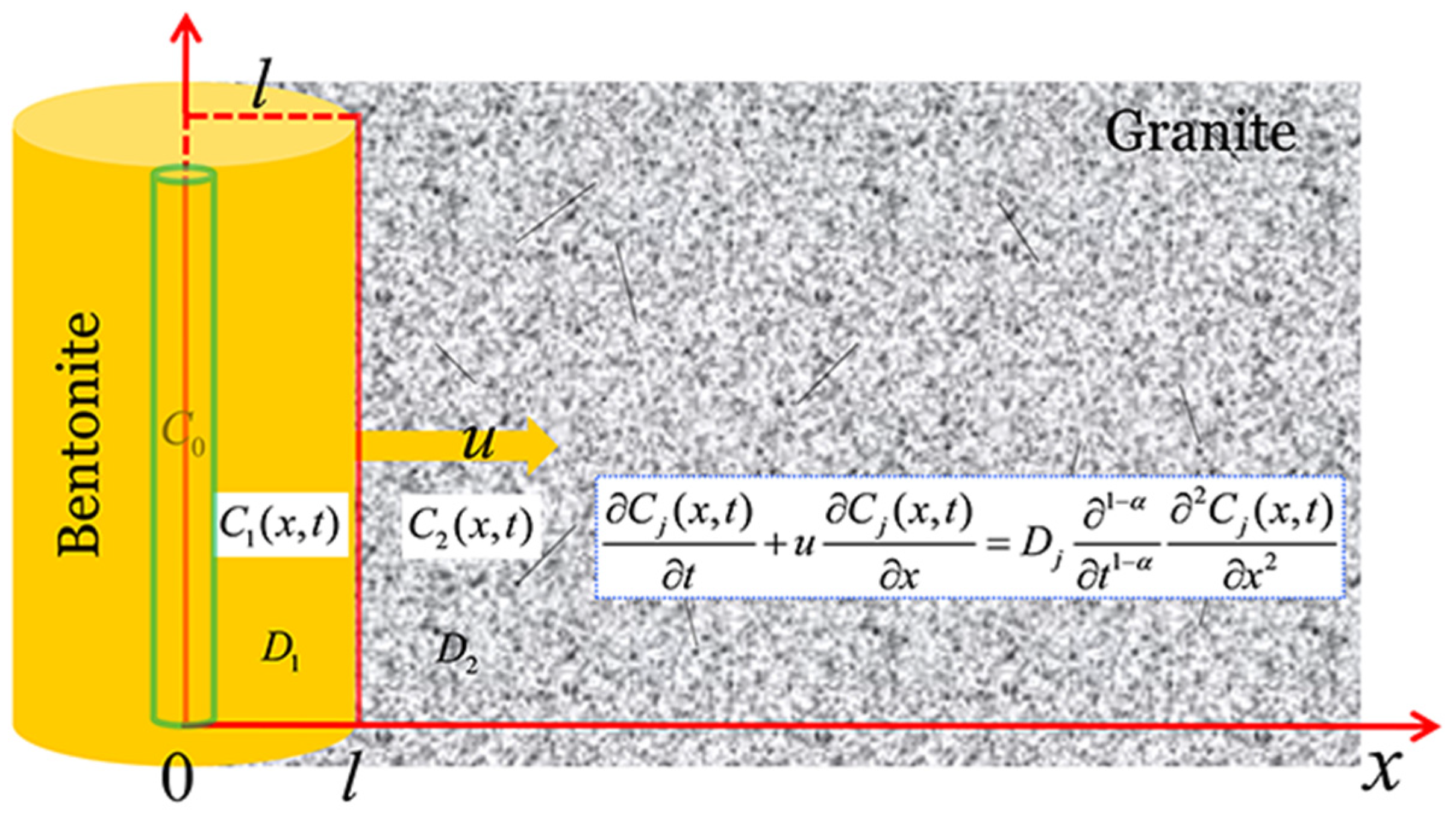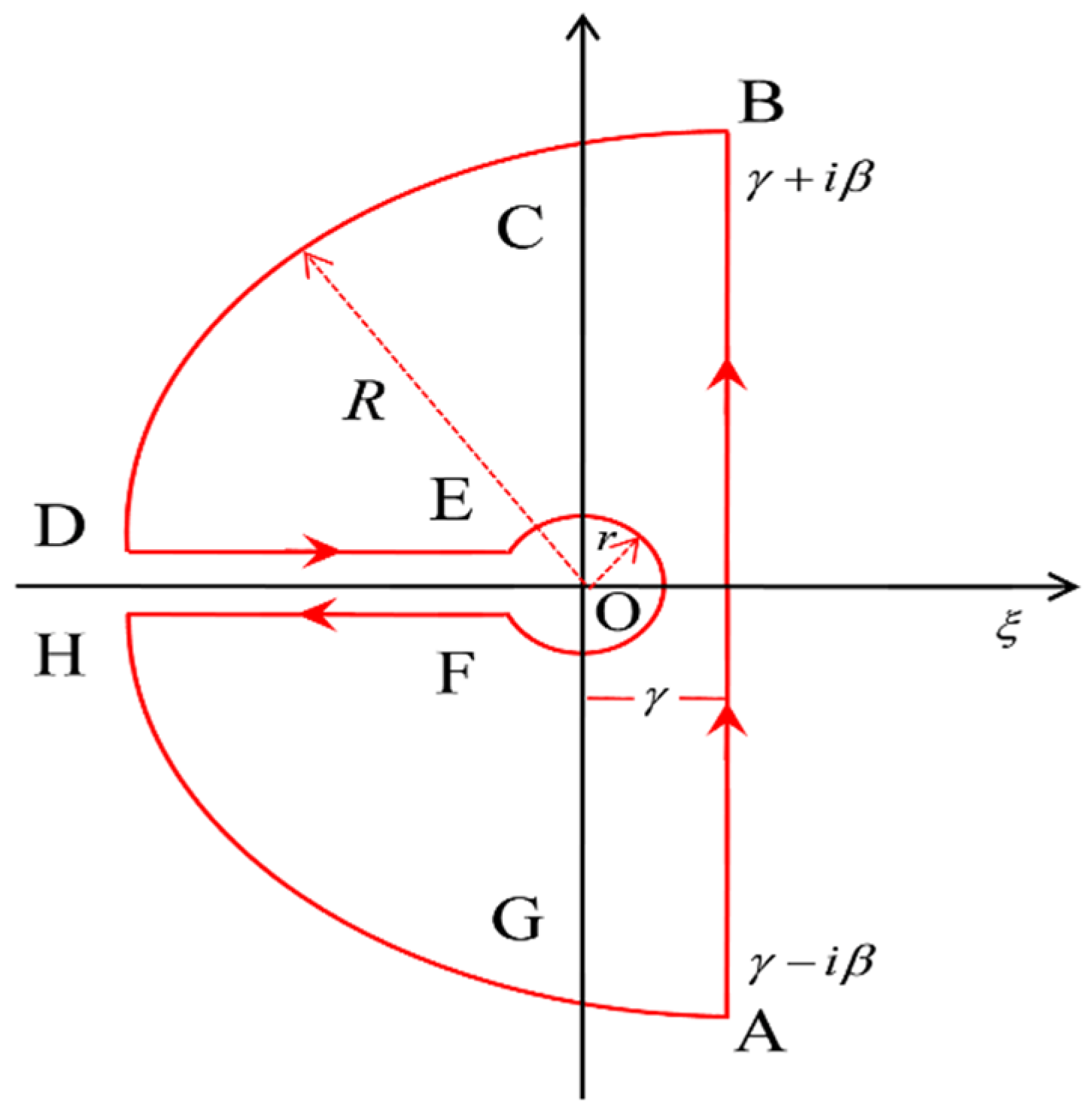Fractional Advection Diffusion Models for Radionuclide Migration in Multiple Barriers System of Deep Geological Repository
Abstract
:1. Introduction
2. Fractional Advection Diffusion Model: Two Adjacent Layers
2.1. Geological Disposal Concept of HLW Repository
2.2. Fractional Advection Diffusion Equations
2.3. Analytical Solutions for FADE in Two Layers
3. Conclusions
Author Contributions
Funding
Institutional Review Board Statement
Informed Consent Statement
Data Availability Statement
Acknowledgments
Conflicts of Interest
References
- Michael, J.A.E.; Apted, J. Geological Repository Systems for Safe Disposal of Spent Nuclear Fuels and Radioactive Waste, 2nd ed.; Woodhead Publishing Series in Energy; Woodhead Publishing: Cambridge, UK, 2017. [Google Scholar]
- Wang, J.; Chen, L.; Su, R.; Zhao, X. The Beishan underground research laboratory for geological disposal of high-level radioactive waste in China: Planning, site selection, site characterization and in situ tests. J. Rock Mech. Geotech. Eng. 2018, 10, 411–435. [Google Scholar] [CrossRef]
- Zhou, H.W.; Yang, S.; Zhang, S.Q. Conformable derivative approach to anomalous diffusion. Phys. A Stat. Mech. Its Appl. 2018, 491, 1001–1013. [Google Scholar] [CrossRef]
- Metzler, R.; Klafter, J. The random walk’s guide to anomalous diffusion: A fractional dynamics approach. Phys. Rep. 2000, 339, 1–77. [Google Scholar] [CrossRef]
- Li, G.H.; Zhang, H.; Zhang, B. Continuous time random walk with A→B reaction in flows. Phys. A Stat. Mech. Its Appl. 2019, 532, 121917. [Google Scholar] [CrossRef]
- Namba, T.; Rybka, P.; Voller, V. Some comments on using fractional derivative operators in modeling non-local diffusion processes. J. Comput. Appl. Math. 2021, 381, 113040. [Google Scholar] [CrossRef]
- Kundu, S. Suspension concentration distribution in turbulent flows: An analytical study using fractional advection-diffusion equation. Phys. A Stat. Mech. Its Appl. 2018, 506, 135–155. [Google Scholar] [CrossRef]
- Xia, Y.; Zhang, Y.; Green, C.T.; Fogg, G.E. Time-fractional flow equations (t-FFEs) to upscale transient groundwater flow characterized by temporally non-Darcian flow due to medium heterogeneity. Water Resour. Res. 2021, 57, e2020WR029554. [Google Scholar] [CrossRef]
- Yang, S.; Wang, L.P.; Zhang, S.Q. Conformable derivative: Application to non-Darcian flow in low-permeability porous media. Appl. Math. Lett. 2018, 79, 105–110. [Google Scholar] [CrossRef]
- Baigereyev, D.; Alimbekova, N.; Berdyshev, A.; Madiyarov, M. Convergence analysis of a numerical method for a fractional model of fluid flow in fractured porous media. Mathematics 2021, 9, 2179. [Google Scholar] [CrossRef]
- Yang, S.; Zhou, H.W.; Zhang, S.Q.; Ren, W.G. A fractional derivative perspective on transient pulse test for determining the permeability of rocks. Int. J. Rock Mech. Min. Sci. 2019, 113, 92–98. [Google Scholar] [CrossRef]
- Moreira, D.; Xavier, P.; Palmeira, A.; Nascimento, E. New approach to solving the atmospheric pollutant dispersion equation using fractional derivatives. Int. J. Heat Mass Transf. 2019, 144, 118667. [Google Scholar] [CrossRef]
- Palmeira, A.; Xavier, P.; Moreira, D. Simulation of atmospheric pollutant dispersion considering a bi-flux process and fractional derivatives. Atmos. Pollut. Res. 2020, 11, 57–66. [Google Scholar] [CrossRef]
- Chaudhary, M.; Singh, M.K. Anomalous transport for multispecies reactive system with first order decay: Time-fractional model. Phys. Scr. 2022, 97, 074001. [Google Scholar] [CrossRef]
- Feng, C.Q.; Si, X.H.; Li, B.T.; Cao, L.M.; Zhu, J. An inverse problem to simulate the transport of chloride in concrete by time-space fractional diffusion model. Inverse Probl. Sci. Eng. 2021, 29, 2429–2445. [Google Scholar] [CrossRef]
- Wei, Q.; Yang, S.; Zhou, H.W.; Zhang, S.Q.; Li, X.N.; Hou, W. Fractional diffusion models for radionuclide anomalous transport in geological repository systems. Chaos Solitons Fractals 2021, 146, 110863. [Google Scholar] [CrossRef]
- Yu, X.; Zhang, Y.; Sun, H.; Zheng, C. Time fractional derivative model with Mittag-Leffler function kernel for describing anomalous diffusion: Analytical solution in bounded-domain and model comparison. Chaos Solitons Fractals 2018, 115, 306–312. [Google Scholar] [CrossRef]
- Pandey, A.K.; Singh, M.K.; Pasupuleti, S. Solution of 1D space fractional advection-dispersion equation with nonlinear source in heterogeneous medium. J. Eng. Mech. 2020, 146, 04020137. [Google Scholar] [CrossRef]
- Yin, M.; Ma, R.; Zhang, Y.; Wei, S.; Tick, G.R.; Wang, J.; Sun, Z.; Sun, H.; Zheng, C. A distributed-order time fractional derivative model for simulating bimodal sub-diffusion in heterogeneous media. J. Hydrol. 2020, 591, 125504. [Google Scholar] [CrossRef]
- Dehghan, M. Numerical solution of the three-dimensional advection–Diffusion equation. Appl. Math. Comput. 2004, 150, 5–19. [Google Scholar] [CrossRef]
- Sunthrayuth, P.; Aljahdaly, N.H.; Ali, A.; Shah, R.; Mahariq, I.; Tchalla, A.M.J. ϕ-Haar Wavelet Operational Matrix Method for Fractional Relaxation-Oscillation Equations Containing ϕ-Caputo Fractional Derivative. J. Funct. Spaces 2021, 2021, 7117064. [Google Scholar] [CrossRef]
- Gómez-Aguilar, J.; López-López, M.; Alvarado-Martínez, V.; Reyes-Reyes, J.; Adam-Medina, M. Modeling diffusive transport with a fractional derivative without singular kernel. Phys. A Stat. Mech. Its Appl. 2016, 447, 467–481. [Google Scholar] [CrossRef]
- Caputo, M. Linear models of dissipation whose Q is almost frequency independent-II. Geophys. J. R. Astron. Soc. 1967, 13, 529–539. [Google Scholar] [CrossRef]
- Caputo, M.; Fabrizio, M. A new definition of fractional derivative without singular kernel. Prog. Fract. Differ. Appl. 2015, 1, 73–85. [Google Scholar] [CrossRef]
- Atangana, A.; Baleanu, D. New fractional derivatives with nonlocal and non-singular kernel: Theory and application to heat transfer model. Therm. Sci. 2016, 20, 763–769. [Google Scholar] [CrossRef] [Green Version]


Publisher’s Note: MDPI stays neutral with regard to jurisdictional claims in published maps and institutional affiliations. |
© 2022 by the authors. Licensee MDPI, Basel, Switzerland. This article is an open access article distributed under the terms and conditions of the Creative Commons Attribution (CC BY) license (https://creativecommons.org/licenses/by/4.0/).
Share and Cite
Yang, S.; Wei, Q.; An, L. Fractional Advection Diffusion Models for Radionuclide Migration in Multiple Barriers System of Deep Geological Repository. Mathematics 2022, 10, 2491. https://doi.org/10.3390/math10142491
Yang S, Wei Q, An L. Fractional Advection Diffusion Models for Radionuclide Migration in Multiple Barriers System of Deep Geological Repository. Mathematics. 2022; 10(14):2491. https://doi.org/10.3390/math10142491
Chicago/Turabian StyleYang, Shuai, Qing Wei, and Lu An. 2022. "Fractional Advection Diffusion Models for Radionuclide Migration in Multiple Barriers System of Deep Geological Repository" Mathematics 10, no. 14: 2491. https://doi.org/10.3390/math10142491
APA StyleYang, S., Wei, Q., & An, L. (2022). Fractional Advection Diffusion Models for Radionuclide Migration in Multiple Barriers System of Deep Geological Repository. Mathematics, 10(14), 2491. https://doi.org/10.3390/math10142491





